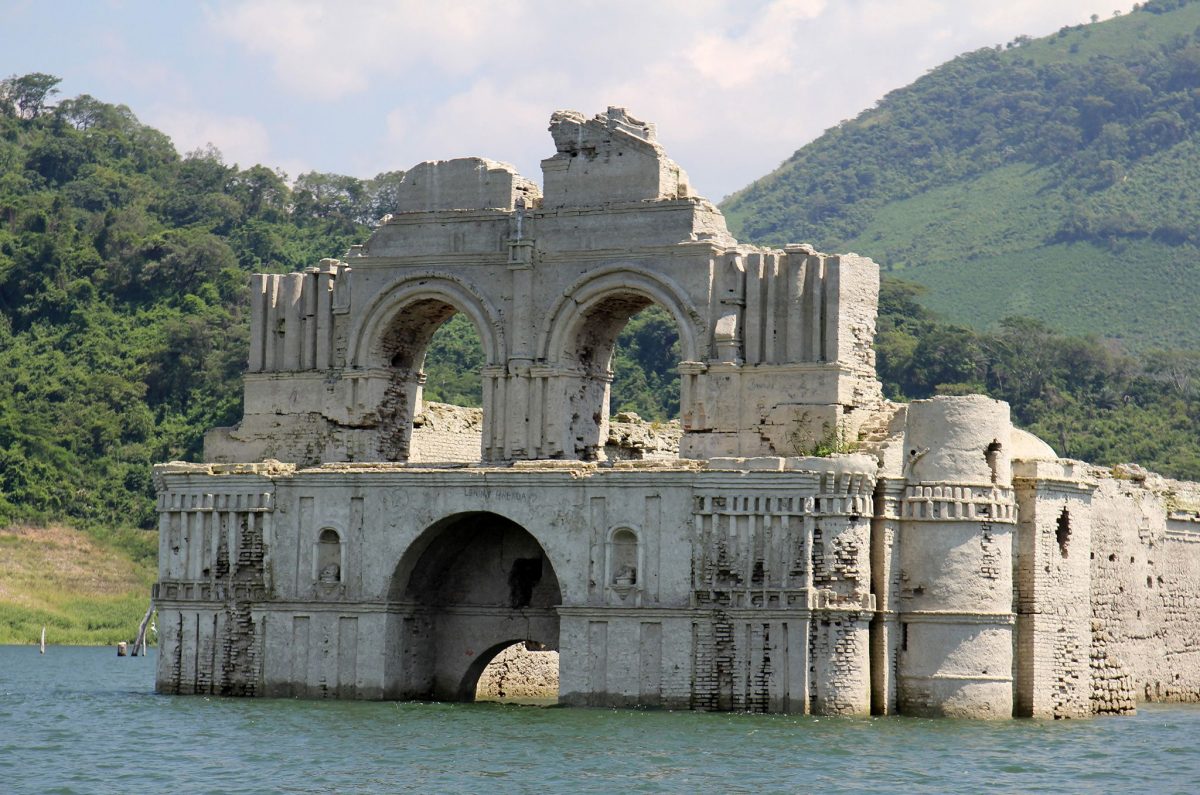Chiapas es un estado que tiene un sinfín de lugares mágicos por descubrir y sin embargo, es de los estados que pocas personas se atreven a descubrir. Uno de los lugares más emblemáticos del estado es San Cristóbal de las Casas, el Templo y Ex-Convento Santo Domingo, que alberga una iglesia barroca y un museo, pero hay otro destino totalmente inaudito: la iglesia sumergida de Quechula.
En la Presa Malpaso o la presa Nezahualcóyotl, al noroeste de Chiapas está la iglesia de Quechula, una construcción del siglo XVI. Su edificación comenzó pocos años después de que la orden llegara a Nueva España. Durante sus años de esplendor se piensa que fue una de las basílicas más grandes de Chiapas, pero hoy sólo quedan ruinas que si desciende el agua lo suficiente, puede verse.
¿Cómo llegar a la iglesia hundida de Quechula, Chiapas?
Pilastras, arcos y ornamentos de cantera decoraron la fachada del Templo de Santiago en Quechula. Sin embargo, el espacio fue abandonado en algún momento del tiempo. Los arqueólogos del Instituto Nacional de Arqueología e Historia (INAH) en México piensan que debido a la orografía de la región, eventualmente el Río Grijalva se desbordó, haciendo que la iglesia quedara completamente sumergida.
Durante siglos, el agua del río mantuvo el templo hundido, pero en 1966 cuando los niveles del agua descendieron se pudo ver la parte superior de la iglesia. Algunas de sus paredes principales se vencieron por las condiciones ambientales, pero el esqueleto del templo aún permanece y puede verse en un paseo turístico.
El templo en ruinas es tan solo una reliquia de la majestuosa construcción dominica del siglo XVI, se ubica muy cerca del complejo arquitectónico de Tecpatán, el ex Convento de Santo Domingo. Tomando como referencia la fundación del convento de Tecpatán en 1564, hace presumir que el templo de Quechula fue posterior, existen similitudes en su arquitectura. Actualmente Quechula forma parte de la ruta de Zoque, una actividad obligatoria por tu viaje hacia el sureste de México.
La iglesia se encuentra e el Río Grijalva y báscamente la única manera de llegar es contratando un paseo en lancha que te lleve a descubrir el río. Una forma de hacerlo es contratando un tour operador de Visit Chiapas, que cuesta cerca de $2,500 para 4 personas. Los paseos incluyen la visita a la iglesia hundida de Quechula y plantaciones de cacao, transporte, kit de seguridad, una experiencia sensorial y de más.
INGLES
Chiapas is a state that has endless magical places to discover and yet, it is one of the states that few people dare to discover. One of the most emblematic places in the state is San Cristóbal de las Casas, the Temple and Ex-Convent of Santo Domingo, which houses a Baroque church and a museum, but there is another totally unusual destination: the submerged church of Quechula.
In the Malpaso Dam or the Nezahualcóyotl Dam, in the northwest of Chiapas is the church of Quechula, a construction from the 16th century. Its construction began a few years after the order arrived in New Spain. During its years of splendor it is thought that it was one of the largest basilicas in Chiapas, but today there are only ruins that can be seen if the water goes down enough.
How to get to the sunken church of Quechula, Chiapas?
Pilasters, arches and quarry ornaments decorated the facade of the Temple of Santiago in Quechula. However, the space was abandoned at some point in time. Archaeologists from the National Institute of Archeology and History (INAH) in Mexico think that due to the orography of the region, the Grijalva River eventually overflowed its banks, causing the church to be completely submerged.
For centuries, the water from the river kept the temple submerged, but in 1966 when the water levels dropped, the upper part of the church could be seen. Some of its main walls have collapsed due to environmental conditions, but the skeleton of the temple still remains and can be seen on a tourist walk.
The temple in ruins is just a relic of the majestic Dominican construction of the 16th century, it is located very close to the architectural complex of Tecpatán, the former Convent of Santo Domingo. Taking the foundation of the Tecpatán convent in 1564 as a reference, it presumes that the Quechula temple was later, there are similarities in its architecture. Quechula is currently part of the Zoque route, a mandatory activity for your trip to the southeast of Mexico.
The church is located on the Grijalva River and basically the only way to get there is by hiring a boat ride that will take you to discover the river. One way to do it is by hiring a tour operator from Visit Chiapas, which costs about $2,500 for 4 people. The tours include a visit to the sunken church of Quechula and cacao plantations, transportation, safety kit, a sensory experience and more.

